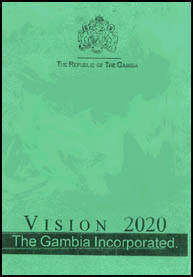 ECONOMY ECONOMY |

Since independence in 1965, the Gambian economy is still dominated by Agriculture, with groundnut production as its principal cash crop. Due to vagaries of weather, this economic sector continues to be severely constrained in terms of output compared with production inputs and therefore resulting to continuous decline in our overall gross domestic products and foreign exchange earnings.
In an endeavor to reverse this decline in the economy, the government had put in place the Economic Recovery Program (ERP) in 1985, which placed emphasis on major policy reforms in key economic agents as well as sectors. These reforms include inter alia: Liberalization of foreign exchange, divestiture and privatization of parastatals and government shares in other enterprises, reforms in key institutions providing support services to tile private sector, and liberalization of business activities with less interference by the government in the interactions of various economic agents in the country.
The success of the Economic Recovery Program could be measured against the average annual growth of about 5% registered during the period 1985/90. Foreign exchange is no longer a major constraint and re-export trade due to the proximity of the Gambia to major European destinations and the sub-region, was on the increase and similarly, other economic sectors registered growth with the multiplier effects on the growth in the Gross Domestic Products and reduction in the government Budget deficits.
| The ERP was succeeded by the Program for Sustained Development (PSD). This also placed emphasis on consolidating the achievements made under the ERP with the major policy thrust of private sector led-growth through further diversification of economic activity and provision of more incentives to enhance private sector participation in tile economic development process.
In its effort to create an environment that offers the most conducive atmosphere for economic and industrial development and to allow for a broad based development which impacts significantly on its population, the government of The Gambia unveiled a 20-year plan to usher the country into the class of a middle-income economy. Dubbed Vision 2020, the plan expresses the wish
To transform The Gambia into a financial centre, a tourist paradise, a trading, export-oriented agricultural and manufacturing nation, thriving on free market policies and a vibrant private sector, sustained by a well-educated, trained, skilled, healthy, self-reliant and enterprising population, and guaranteeing a well-balanced eco-system and a decent standard of living for one and all, under a system of government based on the consent of the citizenry
 Trade Gateway Project Trade Gateway Project |
The Government of the Gambia is at an advanced stage of preparations for the implementation of the Trade Gateway Project, whose overall objective is to develop and promote The Gambia to become the regional centre for processing, manufacturing, assembly, and distribution in West Africa. The project will facilitate the establishment of Free Zone Authority (FZA) and the creation of export processing zones, specially developed for activities that are export-oriented and involve warehousing, sorting, packing, minor processing and assembly. Investors will benefit from a number of one-stop-shop services and facilities, including the entire infrastructure they need for operating profitable investment undertakings |

